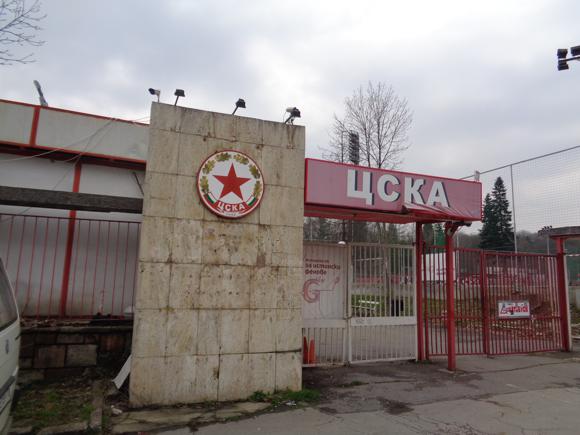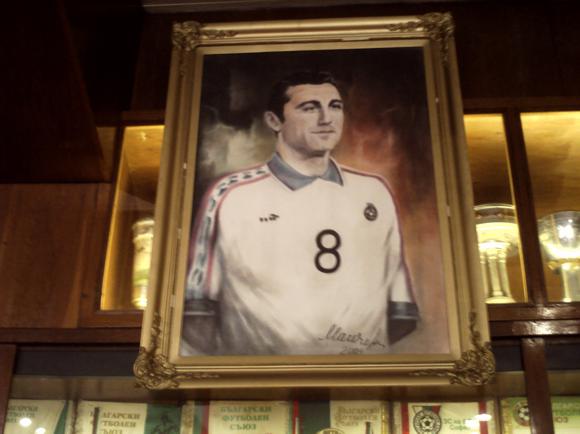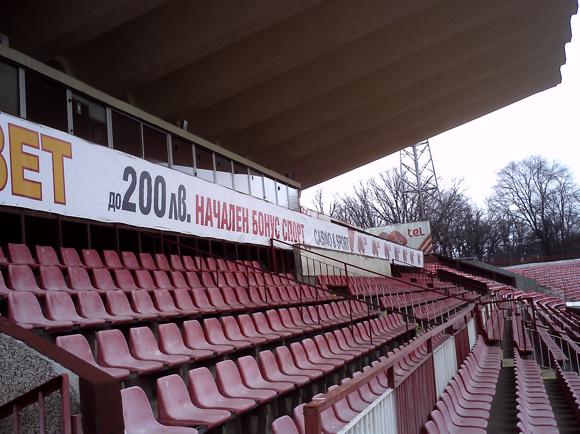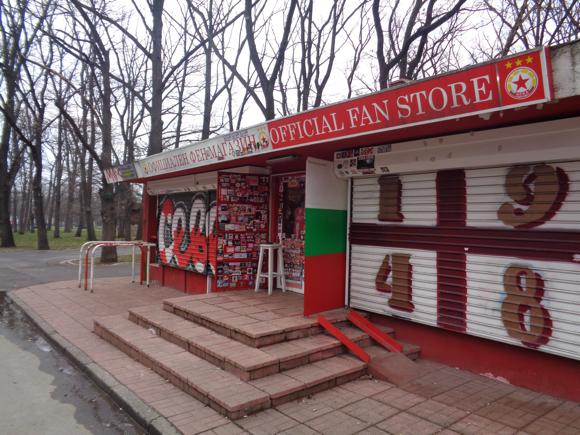A fan’s guide – the club from early doors to today
Anyone visiting the Bulgarian Army Stadium, with its extensive honours board in the main entrance, its museum gleaming with silverware and its prominent sign of a five-pointed star badge with the foundation date of ‘1948’ clearly beneath it, would be forgiven for thinking that this was the home of record champions CSKA Sofia.
CSKA Sofia as in Hristo Stoichkov, CSKA Sofia as in the team who toppled Liverpool, Nottingham Forest and Ajax when each held the European Cup, CSKA Sofia as in the military team in the classic mould of the former Communist system who won nine league titles in a row from the time Stalinist leader Todor Zhivkov assumed control of Bulgaria in 1954.
But it’s not. Debt-ridden CSKA Sofia were condemned to the third division in 2015. As of 2016-17, the team that plays here now is Litex Lovech, renamed CSKA Sofia and moved to the Bulgarian capital. They may play in the same red shirts, claim the same track record and attract the many of the same fans, but they are, as the terrace chant might have it, Litex in disguise.

In June 2015, oligarch and owner of Litex the firm and Litex the football club, Grisha Ganchev, took control of CSKA. Already notorious in his business dealings and successful in taking the team from his home town of Lovech to four league crowns, Ganchev first tried to swap the identities of his two clubs.
When that didn’t work, still saddled with the huge financial burden left by CSKA’s previous owners, Ganchev persuaded the authorities that Litex could be renamed CSKA and moved into the venerable Bulgarian Army Stadium.
Before that was allowed to happen, CSKA walked away with the 2016 South West V (‘C tier’) title with a goal difference of 136 (!), 31 wins and one draw in 32 matches then, just for good measure, went and won the Bulgarian Cup, the only third-division side to do so. Virtually every man who played that day then left – defender Kiril Dinchev retired at 27 (!) – and, as of July 13, 2016, CSKA no longer exist.
The sports ministry rendered the club’s contract at the Bulgarian Army Stadium null and void, Litex moved in, donned red shirts, and began 2016-17 in Bulgaria’s top-flight A Group.

European football didn’t come into it – CSKA were on a UEFA ban.
CSKA fans were pleased to be playing rivals Levski again, average gates of 4,000-plus the highest in the league over the course of 2016-17. Litex, with relatively few fans anyhow, took the place of Botev Lukovit in the third division.
As if CSKA’s history wasn’t convoluted enough. Formed from a discombobulating array of forebears in 1948, the Central Sport Club of the Army became known by locals as the ‘Chorberi’ or ‘Soup Eaters’, after the regular diet in the military.
Later officially called all kinds of acronyms, most notably CDNA (and most colourfully, ‘Team of the Sofia Garrison’), the Army side won almost everything going. Not unlike their counterparts Honvéd in Hungary and Dukla in Prague, CSKA in their various subsequent guises (CSKA Cherveno Zname, ‘Red Flag’, CSKA Septemvriysko Zname, ‘September Flag’) could offer players a more convivial compulsory military service than being out on maneouvres.
Players of the calibre of Ivan Kolev and Dimitar Yakimov helped CSKA beat Juventus 4-1 in the European Cup of 1960-61, and Bulgaria overcome France and Belgium to reach World Cup finals in 1962 and 1966. Internazionale needed a play-off, in Italy, to see off CSKA in the European Cup semi-final of 1967.
With Dimitar Penev as captain and Petar Zhekov as chief goalscorer, in 1973 CSKA sent the Ajax of Johan Neeskens, Arie Haan and Johnny Rep spinning out of the European Cup they had dominated for three years.

Clough’s Forest fell to Bulgaria’s Soup Eaters in 1980, Bob Paisley’s Liverpool of Dalglish, Rush and Souness in 1982. In the subsequent semi-final, CSKA led Bayern Munich 3-0 just after the quarter-hour mark, only to be pegged back to a 4-3 home win and ultimate aggregate defeat.
As derbies with Levski became more intense, a CSKA side featuring a 19-year-old Hristo Stoichkov became involved in a full-on brawl in the Bulgarian Cup final of 1985, resulting in a lifetime ban for the fiery young forward. Though the authorities later reduced it, they forced the Sofia giants to disband. Each carried on under a different name, CSKA as Sredets.
Things returned to the Bulgarian version of normality after the political changes of 1989, Stoichkov leaving for stardom at Barcelona. He returned briefly in 1998, only to leave on the eve of derby day after petty quarrels with fellow 1994 World Cup heroes Emil Kostadinov and Trifon Ivanov.
Without the support of the generals, CSKA quickly had to sell on great talent such as Dimitar Berbatov, Martin Petrov and Stiliyan Petrov, all later successful in England. Unpopular owner Vasil Bozhkov sacked Serbian coach Miodrag Ješić in 2006 despite wins at Liverpool and Bayer Leverkusen, brought in former star striker Stoichko Mladenov – scorer of both goals against Liverpool back in 1982 – and the club won a record 31st title in 2008 by 16 points over Levski.

Then everyone left, including Mladenov. Incoming owners Mittal, the global steel giant, had been skimping on salaries, and CSKA nearly went under, fielding a youth team at the start of 2008-09.
Despite chaotic club management, a coaching post at CSKA still had allure and players still wanted a European stage to showcase their talent. Dimitar Penev and Lyuboslav Penev kept the club in domestic contention but by 2013 the situation was close to breaking point. Hristo Stoichkov stayed four weeks as coach before ditching.
A consortium of entrepreneurs and star names then took over, the returning Mladenov persuaded the likes of Martin Petrov back and CSKA claimed a runners-up league spot in 2014.
By 2015, debt had pushed the club beyond salvation as a day-to-day professional operation. Consortium head, club president and prominent politician Aleksandar Tomov, responsible for setting up the Mittal deal, stepped out. CSKA were banished to the third division then, a year later in 2016, were effectively no more.
With Ludogorets dominating the Bulgarian league – six titles in the last six seasons – and Europe out of bounds, CSKA/Litex may yet need a reason to exist other than face Levski three times a season.
Stadium Guide
The field of dreams – and the stands around it




The Stadion Bâlgarska Armiya is a classic open-bowl, Communist-era stadium, its heritage underlined by its bright red seating and acronym (ЦСКА) spelled out in Cyrillic lettering across it. Though built in 1967, this is not where Clough’s Forest and Bob Paisley’s Liverpool came to grief. Major European games were played at the national Vasil Levski stadium, which shares the Borisova Gradina park with this sports complex.
Formerly an athletics ground, the then named People’s Army Stadium was rebuilt in the mid 1960s. It could hold 32,000, with one main stand and the rest open to the elements. This same configuration remains, capacity now 23,000, with terracing behind each goal, G sektor the home end with its own ultras group. Narrow sektor B at the opposite south end is for visiting supporters, and is accessed through a separate gate by bearing right at the main entrance, crossing a small car park and turning left.
The best seats are in the main stand, A.
getting there
Going to the stadium – tips and timings

The nearest metro station is the one built for the nearby national stadium, Vasil Levski, on both the red M1 and blue M2 lines. The ground is behind the Sportna Sofia 2000 arena, about a 7-8min walk from the metro station.
getting in
Buying tickets – when, where, how and how much

The ticket outlet is to the right of the main entrance. Admission is 12 Lv/€6 for a seat in covered main stand A, 10Lv/€5 for a seat opposite in open stand V, and 5Lv/€2.50 to stand at either end, home sector G, away sector B.
The game with Levski usually attracts a gate of around 20,000 – otherwise, capacity is rarely tested.
what to buy
Shirts, kits, merchandise and gifts

You’ll find the Official Fan Store (Mon-Sat 11am-6pm, match days) near the gateway to the stadium, stocked with scarves, replica shirts and an impressive array of baseball caps.
club Museum
Explore the club inside and out


Ask nicely and they’ll open up the Museum of CSKA Sporting Glory – otherwise accessed by appointment only – with its own entrance behind the main stand. Silverware won in 27 different sports glitters behind glass. Note also the framed painted portrait of Hristo Stoichkov c.1994.
Where to Drink
Pre-match beers for fans and casual visitors



Borisova Gradina park is dotted with bars and cafés – the most convenient for the ground being the Tuborg bar near the eastern end of the national stadium, close to the path that runs straight up to CSKA. Turn right as exit and you’re at the entrance to CSKA in five minutes – which is why fans tend to use it.
Also close though not really a pre-match bar as such, the Veselo Celo, the Happy Village, is a somewhat bizarre recreation of a typical community in rural Bulgaria that works better in summer when the outdoor barbecue is running. Year-round, you’ll find Tuborg and local Shumensko beer on draught and grilled meat dishes.
Behind the main stand, the otherwise bare stadium bar also serves Shumensko beer, with tables outside and, of course, a red-and-white colour scheme.




